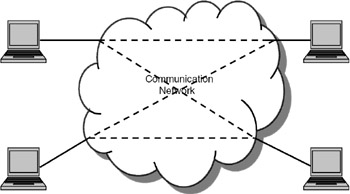15.1 THE BEGINNING OF THE INTERNET
|
| < Day Day Up > |
|
15.1 THE BEGINNING OF THE INTERNET
The threat of a war between the Soviet Union and the United States in the 1960s led to the development of the Internet. The U.S. Department of Defense wanted to develop a computer network that would continue to work even if some portions of the communication network were destroyed by the enemy.
Consider a network of four computers shown in Figure 15.1. If we use the circuit switching operation for communication between any two computers, the procedure is:
-
Establish the connection
-
Transfer the data
-
Disconnection

Figure 15.1: A computer network.
In circuit switching, a connection is established between the two users, data is transferred, and then the circuit is disconnected. The telephone network uses circuit switching to establish voice calls between subscribers.
If the communication link is destroyed, then it is not possible to make the two computers exchange data. This is the inherent problem in a circuit switching operation. If there are alternate communication links, the computers can exchange data, provided the data is routed through the alternate paths, even without the user's knowledge. This led to the concept of packet switching, a revolutionary concept that is fundamental to data communications.
Instead of circuit switching, packet switching is used in computer communication. Packet switching has two main advantages: reliable communication even if some links are not working and call setup and disconnection can be eliminated.
Using the concept of packet switching, the TCP/IP (Transmission Control Protocol/Internet Protocol) suite was developed during 1969-70 when the first form of the Internet, known as DARPANET (Defense Advanced Research Projects Agency Network) was deployed, interconnecting a few sites in the U.S.
Packet switching has two main attractions—providing reliable communications even if some communication links fail and efficient usage of the communication links because no time is lost for call setup and disconnection. However, packet switching requires new protocols to be designed, and we will study these issues in detail in this chapter.
|
| < Day Day Up > |
|
EAN: 2147483647
Pages: 313
- Step 1.2 Install SSH Windows Clients to Access Remote Machines Securely
- Step 2.1 Use the OpenSSH Tool Suite to Replace Clear-Text Programs
- Step 3.3 Use WinSCP as a Graphical Replacement for FTP and RCP
- Step 4.6 How to use PuTTY Passphrase Agents
- Step 4.7 Using Public Key Authentication for Automated File Transfers